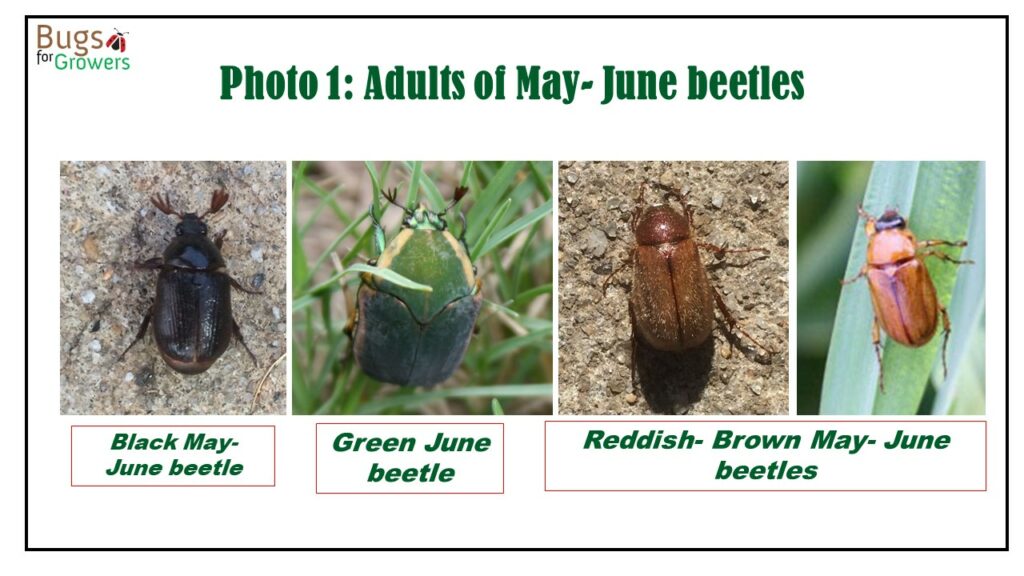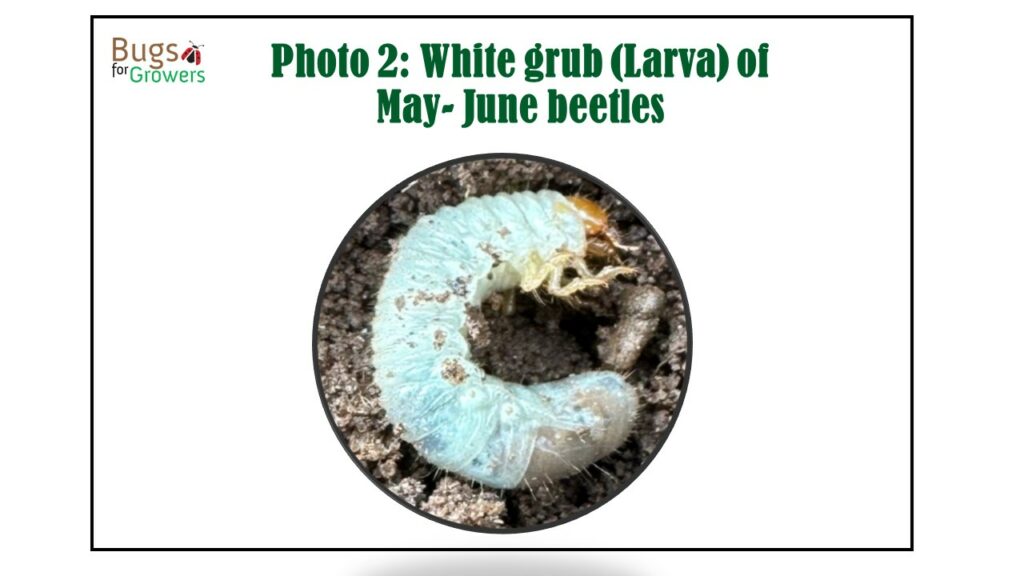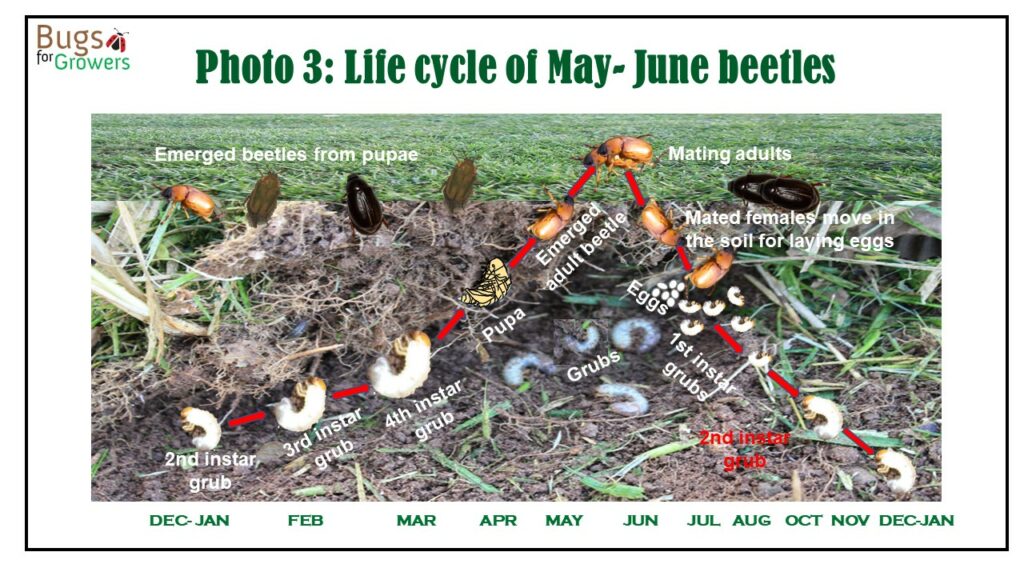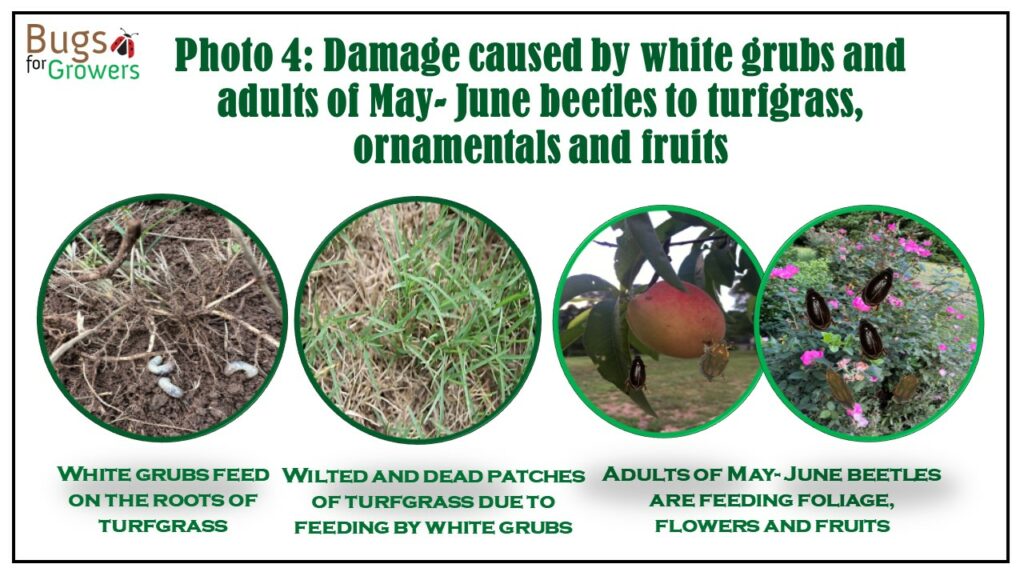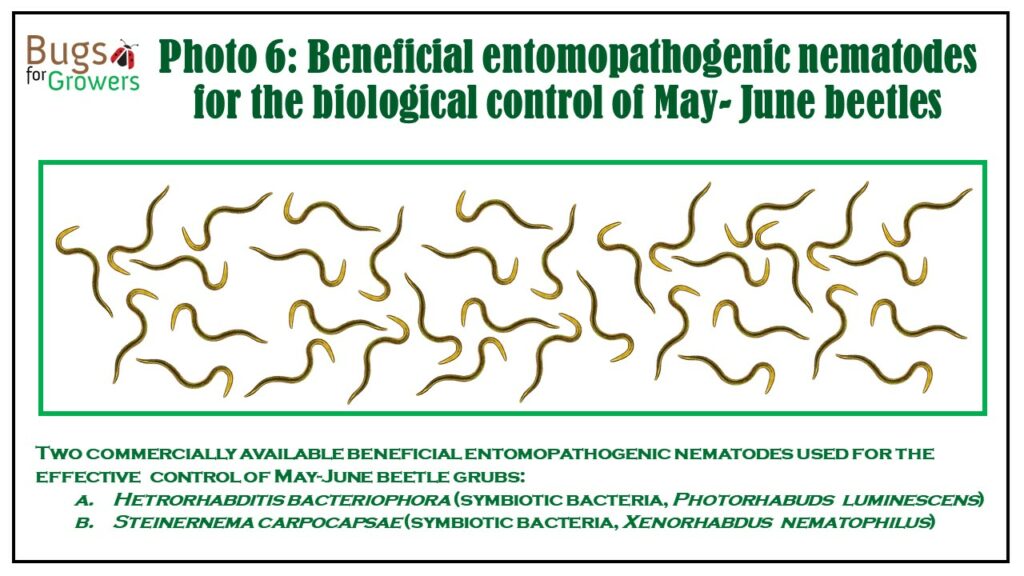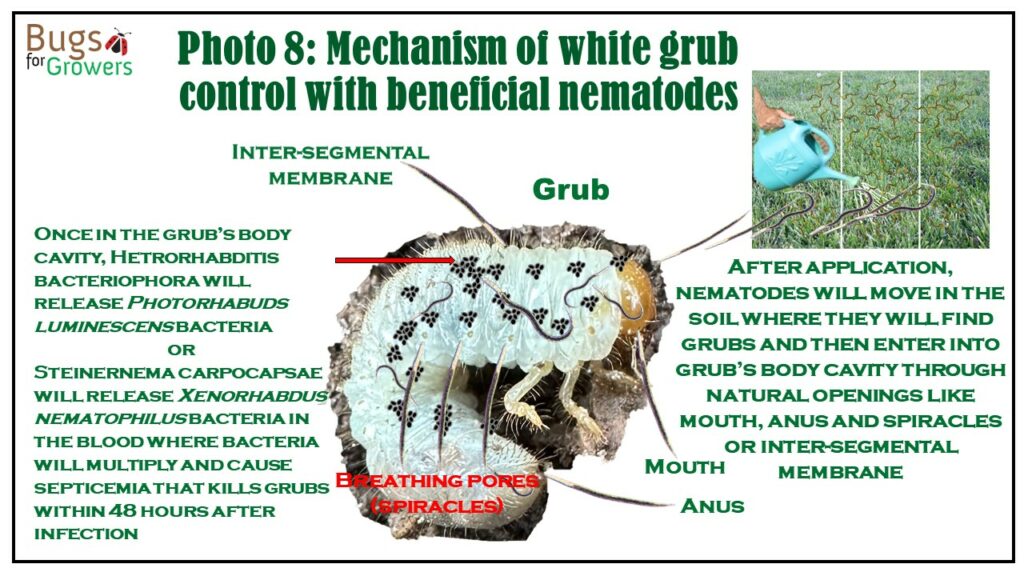What are May/June Beetles?
May-June beetles (Phyllophaga crinita) and Green June beetles (Cotinis nitida) are the most damaging pests of various turfgrasses like Bermudagrass, St. Augustine, and tall fescue, and vegetables and ornamentals. They are named as May- June beetles because they typically emerge annually from their pupae in the soil during the months of May and June.
Adult beetles can be black, green, or reddish-brown in color, measuring about 2 cm in length and 1 cm in width. They possess three pairs of legs, a pair of antennae, two pairs of wings, and chewing mouthparts (Photos 1). After emerging, adults primarily consume the foliage, flowers and ripe fruits (Photo 4).
The larvae of May/ June beetles are also referred to as white grubs, with a whitish-creamy color and a yellowish-brown head capsule. White grubs have three pairs of legs and are approximately 2.5 cm long, adopting a “C” shape at rest (Photo 2). White grubs primarily feed on roots of their host plants (Photo 4).
Life Cycle of May/June Beetles
The life cycle of May and June beetles is generally completed within 1 to 4 years, comprising four developmental stages: adult beetles, eggs, grubs, and pupae (Photo 3). The life cycle typically commences when adults emerge from pupae in late May through early June and begin mating.
After mating, females lay eggs near the roots of turfgrass. Within three weeks, the eggs hatch into small grubs that immediately start feeding on host roots. These grubs progress through three instar stages over the course of three years.
As temperature starts cooling down in the fall, the grubs will move deep into the soil for overwintering and therefore, this is the best time to target grubs with beneficial nematodes before they move deep in the soil (see below).
When temperatures rise in early spring (April), the grubs return to the root zone of turfgrass and start feeding on roots and eventually pupate in the soil and therefore, the spring is the another best season to target grubs and pupae of May- June beetles with beneficial nematodes before they emerges as adults.
After 3-4 weeks, adult May and June beetles emerge from pupae. These beetles are primarily active at night and are attracted towards light. Depending on the location, there can be overlapping generations of May/June beetles, ensuring the presence of immature and mature grubs as well as pupae in the soil each year. This cycle results in their emergence from the soil in May or June annually (Photo 3).
Types of Damage Caused by May/June Beetles
Upon hatching, small grubs feed aggressively on the roots of turfgrass and various agricultural, horticultural, and ornamental plants. Severe infestations of white grubs can lead to extensive yellowing and eventual death of turfgrass. This damage manifests as small dead patches of grass scattered across lawns. As feeding continues, these patches merge, forming larger dead patchy areas that diminish the aesthetic appeal of the turfgrass (Photo 4).
Key indicators of damage caused by May/June beetles include dead patches of turfgrass, which can be easily lifted like a carpet with hands, and evidence of skunks and raccoons digging holes in search of grubs to consume them (Photo 5). In contrast, adult beetles primarily consume plant foliage, flowers and fruits (Photo 4), and their heavy feeding can result into leaf skeletonization, reducing their aesthetic values of ornamental plants and market values of fruits.
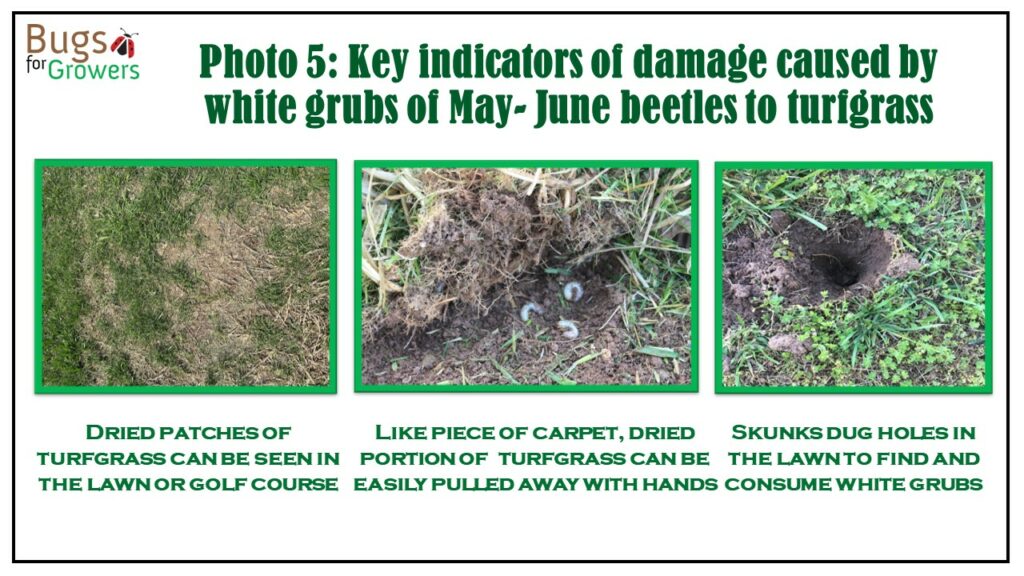
Biological Control of May/June Beetles
Due to the adverse effects of chemical pesticides on humans, animals, and the environment, their use is prohibited for controlling May/June beetle infestations in residential lawns, parks, and golf courses. As an alternative, beneficial entomopathogenic nematodes (Photo 6) can serve as safe biological control agents to manage May/June beetles and mitigate the damage they cause to turfgrass.
Three effective entomopathogenic nematodes, Heterorhabditis bacteriophora, Steinernema carpocapsae and Steinernema scarabaei have been identified as suitable options for controlling May/June beetle grubs. However, Steinernema scarabaei nematodes are not commercially available for this purpose. Therefore, for effective beetle control, application of a mixture of Steinernema carpocapsae and Heterorhabditis bacteriophora nematodes in April is recommended. This nematodes application will eliminate mature grubs preventing their pupation and subsequent emergence as adults in May or June.
Additionally, applying beneficial entomopathogenic nematodes during May and June is effective because of the presence of overlapping generations of their grubs and pupae in the soil. Furthermore, newly emerged mated female beetles lay eggs during this period, and the hatched young grubs are known to be susceptible to beneficial nematodes. This strategy halts the emergence of May/June beetle adults and the movement of grubs into deep soil for overwintering.
Application of Beneficial Nematodes
For effective control of white grubs, apply 25,000 beneficial nematodes per square foot or 1 billion nematodes per acre of turfgrass using water cans equipped with sprinkler heads in late April, May, and early June (Photo 7). Apply the nematodes in the marked areas either early in the morning or late in the evening to prevent exposure to UV light, which can kill nematodes quickly. Since nematodes require a water film for movement in the soil, immediately irrigate the treated area after applying the nematodes.
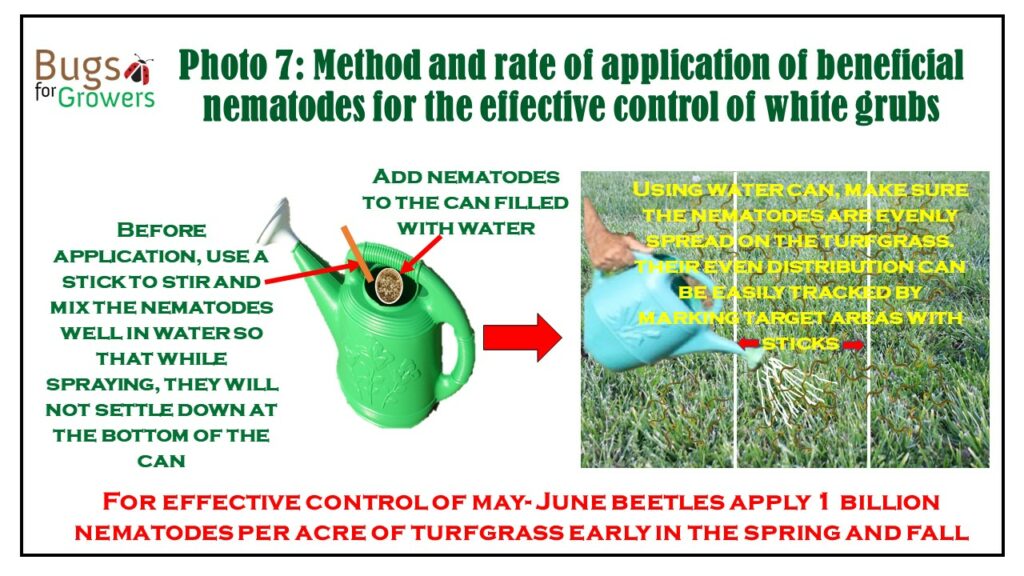
Mechanism of White Grub Control with Beneficial Nematodes
When beneficial nematodes are introduced to the turfgrass, they locate grubs and pupae, entering their body cavity through natural openings such as the mouth, anus, and breathing pores (Photo 8). Once inside, Heterorhabditis bacteriophora nematodes will release symbiotic bacteria, Xenorhabdus nematophilus into the grub’s blood. Steinernema carpocapsae will release Photorhabdus luminescens bacteria into the grub’s bloodstream. These bacteria will multiply, causing septicemia and resulting in the death of mature grubs within 48 hours of infection, thereby preventing the emergence of next generation May/June beetle adults (Photo 8).

